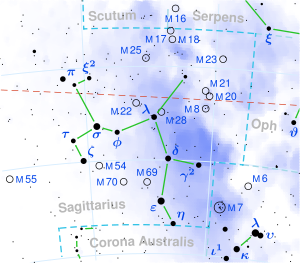로스 154
Ross 154궁수자리 로스 154의 위치 | |
| 관찰 데이터 Epoch J2000 Equinox J2000 | |
|---|---|
| 콘스텔레이션 | 궁수자리 |
| 적경 | 18h 49m 49.36216s[1] |
| 적위 | - 23° 50° 10.4291°[1] |
| 겉보기 등급(V) | 10.44[2] |
| 특성. | |
| 스펙트럼형 | M3.5V[2] |
| B-V 색지수 | 1.76[3] |
| 변수 유형 | 플레어 별[4] |
| 아스트로메트리 | |
| 반지름 속도(Rv) | – 10.7 km[5]/s |
| 고유운동(μ) | RA: +637.02[1] mas/년 Dec.: –191.64[1] mas/년 |
| 시차()) | 336.0266 ± 0.0317 mas[6] |
| 거리 | 9.7063 ± 0.0009 ly (2.9760 ± 0.0003 pc) |
| 절대 등급(MV) | 13.07[2] |
| 세부 사항 | |
| 덩어리 | 0.17[2] M☉ |
| 반지름 | 0.24 ± 0.06[7] R☉ |
| 광도 | 0.0038[8] L☉ |
| 표면 중력(log g) | 5.00 ± 0.05[9] CGS |
| 온도 | 3,340 ± 10[9] K |
| 금속성 [Fe/H] | - 0.25덱스[10] |
| 회전 속도(v sin i) | 3.5 ± 1.5[10] km/s |
| 나이 | 1 Gyr 미만[10] |
| 기타 명칭 | |
| 데이터베이스 참조 | |
| 심바디 | 데이터. |
로스 154(V1216 Sgr)는 궁수자리의 남쪽 별이다.겉보기 등급은 10.[2]44로 육안으로 보기엔 너무 희미하다.적어도 Ross 154를 보려면 이상적인 [12]조건에서 6.5cm(3인치)의 개구부를 가진 망원경이 필요하다.이 별까지의 거리는 지구에서 [1]9.69광년(2.97파섹) 떨어져 있는 시차를 통해 추정할 수 있습니다.이것은 남쪽 궁수자리에서 가장 가까운 별이며 태양에서 가장 가까운 별 중 하나입니다.
묘사
이 별은 1925년 미국 천문학자 프랭크 엘모어 로스에 의해 처음 목록화되었고 그의 네 번째 새로운 변광성 [13]목록의 일부를 형성했다.1926년, 그는 그 위치를 동료 미국 천문학자인 E. E.[14] 바너드가 이전에 찍은 사진 판과 비교한 후 측정 가능한 고유 운동을 보여주는 두 번째 별 목록에 그것을 추가했다.예비 시차 값 0.362 ± 0.006 초는 1937년 월터 오코넬이 남아프리카공화국 요하네스버그에 있는 예일 망원경의 사진 판을 사용하여 구했다.이로 인해 이 별은 당시 알려진 인근 [15]별들의 6번째 위치에 놓이게 되었다.
로스 154는 고래자리 UV형 플레어 별이며, 주 플레어 간격은 평균 [4]약 이틀입니다.이러한 플레어 활동은 1951년 호주에서 처음 관측되었으며, 이때 별의 밝기는 0.[17]4 증가하였다.일반적으로 이 별은 [18]플레어 동안 3~4등급 정도 증가합니다.별의 표면 자기장의 세기는 약 2.2 ± 0.1 [19]kG입니다. 로스 154는 X선 선원이며 여러 개의 X선 관측소에 의해 검출되었습니다.대기 X선 광도는 약 9 × 1027 [10]ergs−1 s이다. 찬드라 천문대에서 X선 플레어 방출이 관측되었으며, 특히 큰 플레어가 2.3 × 1033 [10]erg를 방출하고 있다.
M3.5V의[2] 항성급으로 중심핵에서 수소 핵융합을 통해 에너지를 생산하는 적색왜성이 된다.질량은[2] 태양의 17%, [7]반지름은 24%로 추정되지만, 태양 [8]광도의 0.38%만 방사하고 있습니다.대류가 외부 층에서만 일어나는 태양과 달리 질량이 이렇게 작은 적색왜성은 완전히 [20]대류됩니다.비교적 높은 자전으로 볼 때, 이 별은 아마도 10억 [10]년 미만의 나이를 가진 젊은 별일 것입니다.헬륨보다 무거운 원소들의 양은 [10]태양에 있는 것의 약 절반이다.
로스 [21]154 주변의 궤도에서는 질량이 작은 동반자가 발견되지 않았다.또한 그것은 별 주위 먼지의 존재를 암시하는 과도한 적외선 방출의 수준을 보여주지도 않는다.이러한 파편 원반은 약 1000만년 이상 된 M형 항성계 중 희귀하며, 주로 항성풍의 [22]항력에 의해 제거되었다.은하 좌표계에서 이 별의 우주 속도 성분은 [U, V, W] = [-12.2, –1.0, –7.2] km−1 [23]s입니다.이 행성은 특정 항성 운동[24] 그룹의 구성원으로 확인되지 않았으며 궤도 이심률이 0.052이고 중심핵에서 27.65~30.66kly(8.48~[25]9.40kpc)의 거리를 두고 은하를 돌고 있습니다.태양에 대한 느린 속도로 볼 때 이 별은 젊은 원반 별([26]종족 I)로 추정됩니다.이 별은 약 157,000년 만에 태양에 가장 근접하게 될 것이며, 이때 태양은 6.39 ± 0.10년(1.959 ± 0.031 pc)[27] 이내에 도달하게 된다.
「 」를 참조해 주세요.
레퍼런스
- ^ a b c d e van Leeuwen, F. (November 2007), "Validation of the new Hipparcos reduction", Astronomy and Astrophysics, 474 (2): 653–664, arXiv:0708.1752, Bibcode:2007A&A...474..653V, doi:10.1051/0004-6361:20078357, S2CID 18759600
- ^ a b c d e f g Staff (January 1, 2008), The One Hundred Nearest Star Systems, Research Consortium on Nearby Stars, archived from the original on May 13, 2012, retrieved 2008-06-12
- ^ Corben, P. M.; et al. (1972), "U, B, V photometry of 500 southern stars", Monthly Notes of the Astronomical Society of South Africa, 31: 7–22, Bibcode:1972MNSSA..31....8C
- ^ a b Jarrett, A. H.; Grabner, G. (1976), "On the Period Between Flares of V1216 Sagittarii", Information Bulletin on Variable Stars, 1221 (1221): 1, Bibcode:1976IBVS.1221....1J
- ^ Gontcharov, G. A. (2006), Pulkovo Compilation of Radial Velocities for 35493 Hipparcos Stars, retrieved 2010-04-18
- ^ Brown, A. G. A.; et al. (Gaia collaboration) (2021). "Gaia Early Data Release 3: Summary of the contents and survey properties". Astronomy & Astrophysics. 649: A1. arXiv:2012.01533. Bibcode:2021A&A...649A...1G. doi:10.1051/0004-6361/202039657. S2CID 227254300. (에라타: doi:10.1051/0004-6361/202039657e).VizieR에서 이 소스에 대한 Gaia EDR3 레코드.
- ^ a b 페이지 693 참조Johnson, H. M.; Wright, C. D. (1983), "Predicted infrared brightness of stars within 25 parsecs of the sun", Astrophysical Journal Supplement Series, 53: 643–711, Bibcode:1983ApJS...53..643J, doi:10.1086/190905.
- ^ a b Pettersen, B. R. (1980), "Physical parameters of solar neighbourhood flare stars", Astronomy and Astrophysics, 82 (1–2): 53–60, Bibcode:1980A&A....82...53P
- ^ a b Mentuch, Erin; et al. (2008), "Lithium Depletion of Nearby Young Stellar Associations", The Astrophysical Journal, 689 (2): 1127–1140, arXiv:0808.3584, Bibcode:2008ApJ...689.1127M, doi:10.1086/592764, S2CID 16859859
- ^ a b c d e f g Wargelin, B. J.; et al. (2008), "X-Ray Flaring on the dMe Star, Ross 154", The Astrophysical Journal, 676 (1): 610–627, arXiv:0712.2791, Bibcode:2008ApJ...676..610W, doi:10.1086/528702, S2CID 53357714
- ^ "V* V1216 Sgr -- Flare Star", SIMBAD, Centre de Données astronomiques de Strasbourg, retrieved 2008-06-12
- ^ Mills, H. Robert (1994), Practical Astronomy: A User-friendly Handbook for Skywatchers, Horwood Publishing, pp. 199, ISBN 1-898563-02-0
- ^ Ross, Frank E. (1926), "New variable stars, (fourth list)", Astronomical Journal, 37: 91, Bibcode:1927AJ.....37Q..91R, doi:10.1086/104790
- ^ Ross, Frank E. (February 1926), "New proper-motion stars, (second list)", Astronomical Journal, 36 (856): 124–128, Bibcode:1926AJ.....36..124R, doi:10.1086/104699
- ^ O'Connell, Walter (February 1938), "A faint star of large parallax", Astronomical Journal, 46 (1078): 204, Bibcode:1938AJ.....46..204O, doi:10.1086/105447
- ^ "MAST: Barbara A. Mikulski Archive for Space Telescopes". Space Telescope Science Institute. Retrieved 8 December 2021.
- ^ Mayall, Margaret W. (February 1953), "Variable Star Notes", Journal of the Royal Astronomical Society of Canada, 47: 23–28, Bibcode:1953JRASC..47...23M
- ^ Costa, R.; Cristaldi, S.; Rodono, M. (1970), "Cooperative Observations of the Flare Star V1216 Sgr", Information Bulletin on Variable Stars, 461: 1–4, Bibcode:1970IBVS..461....1C
- ^ Reiners, Ansgar; Basri, Gibor (February 2007). "The First Direct Measurements of Surface Magnetic Fields on Very Low Mass Stars". The Astrophysical Journal. 656 (2): 1121–1135. arXiv:astro-ph/0610365. Bibcode:2007ApJ...656.1121R. doi:10.1086/510304. S2CID 17743657.
- ^ Reiners, Ansgar; Basri, Gibor (March 2009), "On the magnetic topology of partially and fully convective stars", Astronomy and Astrophysics, 496 (3): 787–790, arXiv:0901.1659, Bibcode:2009A&A...496..787R, doi:10.1051/0004-6361:200811450, S2CID 15159121
- ^ Hinz, Joannah L.; et al. (2002), "A Near-Infrared Wide-Field Proper Motion Search for Brown Dwarfs", The Astronomical Journal, 123 (4): 2027–2032, arXiv:astro-ph/0201140, Bibcode:2002AJ....123.2027H, doi:10.1086/339555, S2CID 12737223
- ^ Plavchan, Peter; Jura, M.; Lipscy, S. J. (October 2005), "Where Are the M Dwarf Disks Older Than 10 Million Years?", The Astrophysical Journal, 631 (2): 1161–1169, arXiv:astro-ph/0506132, Bibcode:2005ApJ...631.1161P, doi:10.1086/432568, S2CID 3498251
- ^ "Annotations on V* V1216 Sgr object". SIMBAD. Retrieved 2010-04-18.
- ^ Montes, D.; et al. (2001), "Late-type members of young stellar kinematic groups - I. Single stars" (PDF), Monthly Notices of the Royal Astronomical Society, 328 (1): 45–63, arXiv:astro-ph/0106537, Bibcode:2001MNRAS.328...45M, doi:10.1046/j.1365-8711.2001.04781.x, S2CID 55727428
- ^ Allen, C.; Herrera, M. A. (1998), "The galactic orbits of nearby UV Ceti stars", Revista Mexicana de Astronomía y Astrofísica, 34: 37–46, Bibcode:1998larm.confE.115A
- ^ Veeder, G. J. (1974), "Old disk flare stars", Astronomical Journal, 79: 702–704, Bibcode:1974AJ.....79..702V, doi:10.1086/111600
- ^ Bobylev, V. V. (March 2010), "Searching for stars closely encountering with the solar system", Astronomy Letters, 36 (3): 220–226, arXiv:1003.2160, Bibcode:2010AstL...36..220B, doi:10.1134/S1063773710030060, S2CID 118374161
메모들
외부 링크




